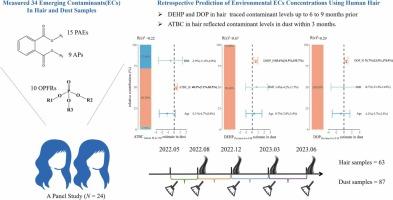利用人类头发对环境新出现的污染物暴露进行回顾性预测:对适用性、可靠性和可用性的见解
IF 11.3
1区 环境科学与生态学
Q1 ENGINEERING, ENVIRONMENTAL
引用次数: 0
摘要
毛发是一种广泛应用于人体生物监测评估的无创基质。然而,其反映各种污染物的功效,以及暴露的浓度和时间尺度,仍未确定。在这项小组研究中,从2022年5月到2023年6月,每季度收集一次头发和室内灰尘样本。测量了34种增塑剂的浓度,这些增塑剂属于三大类:有机磷阻燃剂(OPFRs)、邻苯二甲酸酯(PAEs)和替代增塑剂(APs)。这项研究的目的是确定哪些污染物的头发适合监测,并确定暴露水平和时间段,以便使用广义线性混合模型对污染进行回顾性预测。头发中柠檬酸乙酰三丁酯(ATBC)浓度每增加一个单位,在过去的3个月里,其粉尘水平上升40.3% (95% CI: 7.2%, 83.5%)。回顾性预测显示,在过去的6至9个月中,粉尘中邻苯二甲酸二(2-乙基己基)酯(DEHP)和邻苯二甲酸二正辛酯(DOP)的含量分别增加了83.6% (95% CI: 31.9%, 155.7%)和76.7% (95% CI: 13.5%, 174.9%)。此外,头发中的DEHP和DOP浓度分别占粉尘中DEHP和DOP含量变化的99.60%和100%。我们的研究结果为头发和灰尘配对样本中增塑剂的时间-浓度关系提供了有价值的见解,促进了对头发作为环境暴露的回顾性生物标志物的理解。本文章由计算机程序翻译,如有差异,请以英文原文为准。

Retrospective Prediction of Environmental Emerging Contaminants Exposure Using Human Hair: Insights into Suitability, Reliability, and Availability
Hair is a widely utilized non-invasive matrix for human biomonitoring assessment. Nevertheless, its efficacy in reflecting various pollutants, along with the concentrations and time-scales of exposure, remains undetermined. In this panel study, hair and indoor dust samples were collected quarterly from May 2022 to June 2023. The concentrations of 34 types of plasticizers, belonging to three categories - organophosphate flame retardants (OPFRs), phthalate esters (PAEs), and alternative plasticizers (APs) - were measured. The study aimed to identify which pollutants hair is suitable for monitoring and to determine the exposure levels and time periods over which it can retrospectively predict contamination, using generalized linear mixed models. A one-unit increase in the hair concentration of acetyl tributyl citrate (ATBC) was associated with a 40.3% (95% CI: 7.2%, 83.5%) rise in its level in dust over the preceding 3 months. Retrospective predictions revealed that the levels of di (2-ethylhexyl) phthalate (DEHP) and di-n-octyl phthalate (DOP) in dust increased by 83.6% (95% CI: 31.9%, 155.7%) and 76.7% (95% CI: 13.5%, 174.9%), respectively, over the previous 6 to 9 months. Furthermore, the DEHP and DOP concentrations in hair accounted for 99.60% and 100% of the variance in their levels in dust, respectively. Our findings provide valuable insights into the time-concentration relationships of plasticizers in paired hair and dust samples, advancing the understanding of hair as a retrospective biomarker for environmental exposure.
求助全文
通过发布文献求助,成功后即可免费获取论文全文。
去求助
来源期刊

Journal of Hazardous Materials
工程技术-工程:环境
CiteScore
25.40
自引率
5.90%
发文量
3059
审稿时长
58 days
期刊介绍:
The Journal of Hazardous Materials serves as a global platform for promoting cutting-edge research in the field of Environmental Science and Engineering. Our publication features a wide range of articles, including full-length research papers, review articles, and perspectives, with the aim of enhancing our understanding of the dangers and risks associated with various materials concerning public health and the environment. It is important to note that the term "environmental contaminants" refers specifically to substances that pose hazardous effects through contamination, while excluding those that do not have such impacts on the environment or human health. Moreover, we emphasize the distinction between wastes and hazardous materials in order to provide further clarity on the scope of the journal. We have a keen interest in exploring specific compounds and microbial agents that have adverse effects on the environment.
 求助内容:
求助内容: 应助结果提醒方式:
应助结果提醒方式:


